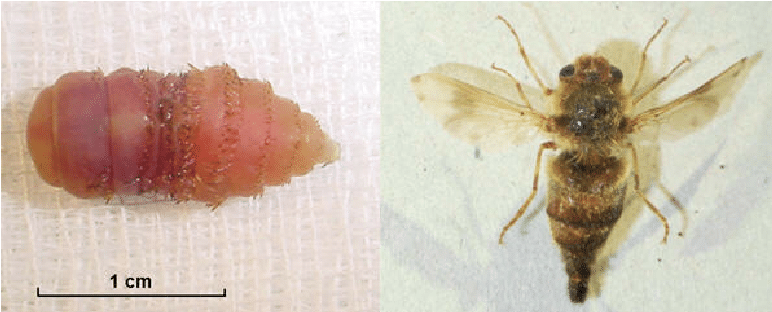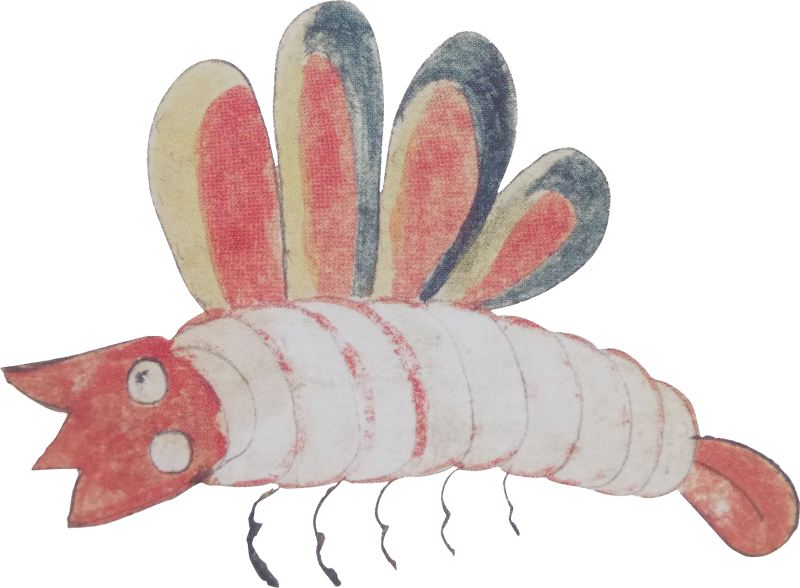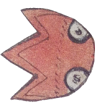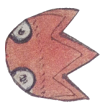
DAY NINE: HAIMUSHI
("Lung Bug")
Written by Jonathan Wojcik, Researched and Translated by Rev Storm
Despite living in the lungs, Haimushi eats its victim's food, and it's not the only time the organ inhabited by a Belly Bug seems kind of arbitrary. A lot of them live in the lungs or spleen or kidneys and still parasitize the digestive tract. I guess, to be fair, we don't live in the grocery store.
Haimushi is said to emerge from the lungs and go flying now and then, sometimes traveling so far that it can become lost. What's very bizarre here is that if the Haimushi can't return to its host, the host dies, and then Haimushi transforms into a hitodama - a disembodied soul resembling a pale fireball. There's no explanation for this, but it almost sounds like this little scamp takes your soul with it when it goes out sightseeing.
Design Review:
Lovable and adorable! The Gyoshu-like face is a lot of fun on a "flying maggot" body, the whole creature feeling like some dark, distorted butterfly, and the tongue tail is a very creative touch. Rev and I also both love how the pupil on one eye is missing. It probably wasn't painted that way, but it just adds something to its personality anyway.TODAY'S REAL WORLD PARASITE:
Gasterophilus intestinalis

You probably know a bit about bot flies already; that as larvae, they develop just under the skin of a mammalian host, feeding on mucus and other bodily secretions until finally emerging as a furry little adult. What some of you may not know, however, is that some bot flies are subdermal - living in the skin - while other bot flies are visceral, living within the body organs. Intestinalis is one such bot fly, and it normally only afflicts horses, but human infections have happened by mistake.
The female Gasterophilus begins by landing on the host's face and laying eggs around the lips, the intention being that the host will lick them into its mouth. It's not often that a human will allow a fly to do all this, but that's why when human infection does happen, and it's thankfully still pretty rare, it mostly befalls babies and toddlers. APPETIZING.
The eggs hatch within the mouth, and there they develop up to their second larval instar. They then let go of the gums, tongue or cheek lining and allow themselves to be swallowed, where they reach their third stage inside the stomach. That's pretty impressive, given that even tapeworms don't remain in the stomach itself, but prefer the intestines where digestive enzymes are far more diluted. Perhaps it's the chitinous shell of these insect larvae that helps them resist direct exposure to acid? Whatever the case, they embed themselves within the stomach lining and feed on host blood until they're ready to pupate, at which point they release themselves and will pass out with the host's feces.
I think it should be obvious why I choose a bot fly to pair with Haimushi; a winged maggot that comes and goes from the internal organs isn't that far of a cry from an actual maggot that develops in the stomach and takes flight when it reaches maturity. We're just lucky that bot flies, unlike Lung Bug, don't ever try to come back in after they've gone on their little joyride.


































